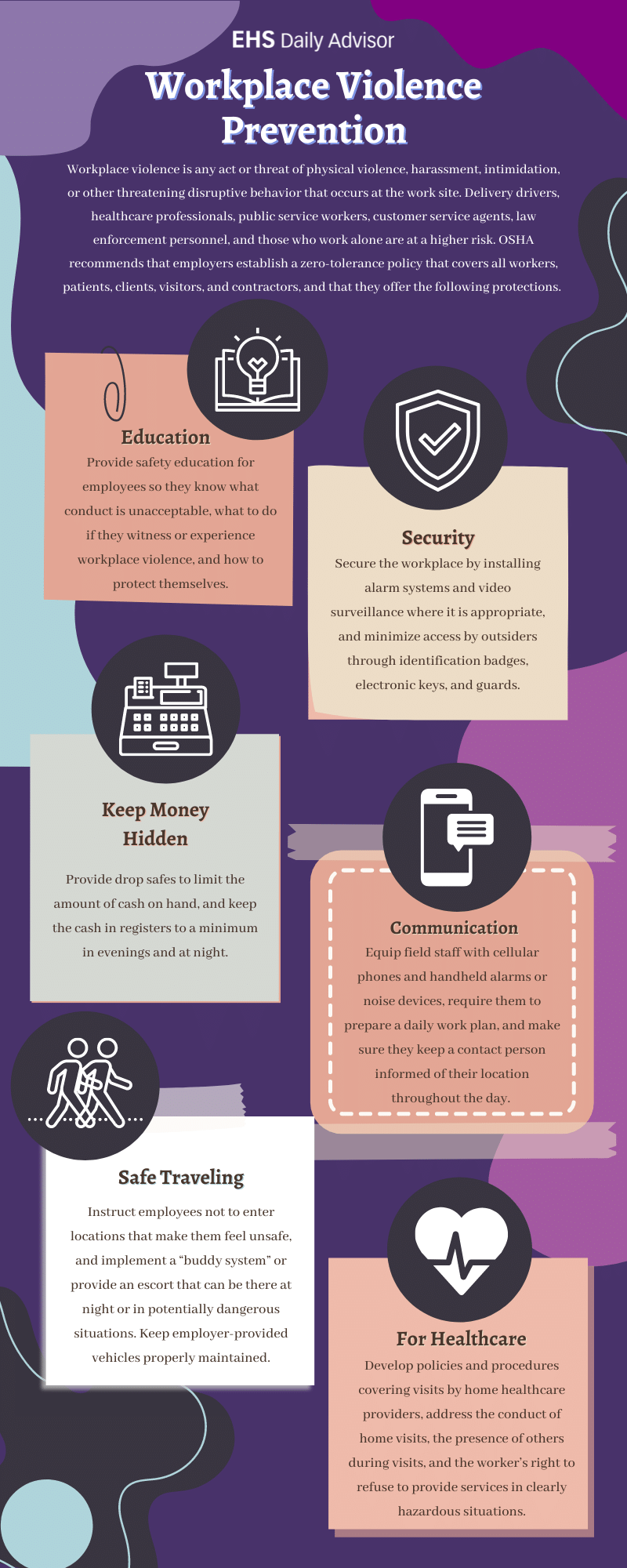Comprehending Legal Needs for California Workplace Violence Prevention Programs
Comprehending Legal Needs for California Workplace Violence Prevention Programs
Blog Article
Examining the Impact of Workplace Culture on the Success of Physical Violence Prevention Efforts and Staff Member Wellness
The crossway of workplace culture, violence prevention initiatives, and worker health warrants cautious assessment, as these components collectively affect business success. A society that focuses on open communication and mental safety can empower staff members to identify and report prospective threats, thereby cultivating an atmosphere for both psychological wellness and effective physical violence avoidance approaches. The subtleties of exactly how these factors interact remain complex and complex. Comprehending the particular systems at play can reveal critical understandings that may inform future campaigns and drive meaningful adjustment within companies. What underlying dynamics might be influencing these outcomes?
Comprehending Office Society
Frequently, workplace culture serves as the foundation for employee communications and general organizational behavior. It encompasses the common values, ideas, and techniques that shape the environment in which staff members operate. A favorable workplace society fosters partnership, respect, and open communication, while an unfavorable society might reproduce stress, wonder about, and hostility. Recognizing workplace society is vital for companies aiming to execute effective violence prevention strategies.

Organizations have to assess their existing work environment society to determine locations for enhancement. This analysis can include surveys, emphasis teams, or one-on-one conversations. By acknowledging the social characteristics at play, organizations can execute targeted interventions that promote a more secure and more considerate work setting, inevitably lowering the danger of violence in the office.
Duty of Staff Member Well-Being
A favorable workplace culture not only influences organizational habits however likewise substantially impacts employee health. When employees really feel valued and respected, their total task complete satisfaction increases, causing enhanced emotional and mental health. This, in turn, fosters a sense of belonging and loyalty, which is essential for lasting involvement and performance.
Moreover, a supportive social environment promotes open communication, making it possible for employees to share concerns and seek assistance without fear of stigma. This openness is essential in attending to concerns related to anxiety, fatigue, and interpersonal disputes, which can negatively influence both individual well-being and organizational consistency.
In addition, companies that prioritize employee wellness usually see decreased absenteeism and turn over prices. Healthy workers are extra resilient and better outfitted to deal with work environment obstacles, adding to a more efficient and secure workforce.
Purchasing worker well-being through efforts such as health cares, psychological wellness sources, and flexible working arrangements can produce a favorable feedback loop, improving both private gratification and cumulative business success (california workplace violence prevention). Ultimately, prioritizing staff member health is not merely a moral imperative; it is a tactical technique that profits the entire company
Physical Violence Prevention Methods
Implementing efficient physical violence avoidance techniques is crucial for preserving a secure and healthy and balanced office setting. Organizations must adopt a comprehensive method that includes policy development, website link staff member training, and positive communication. Establishing clear workplace violence plans is the first action, making sure that all employees recognize acceptable actions and the repercussions of violations.
Educating programs must be designed to enlighten employees concerning acknowledging caution signs of possible violence, problem resolution techniques, and emergency situation reaction treatments. Regular drills and simulations can boost preparedness, cultivating a culture of recognition and responsibility.
Furthermore, cultivating open communication networks encourages staff members to report issues without fear of revenge. This can be facilitated via confidential reporting systems or normal comments sessions. Additionally, advertising an encouraging work environment society that values respect and inclusivity can substantially alleviate the risk of physical violence.
Organizations ought to also engage in routine assessments of their workplace culture and physical violence prevention strategies, adjusting them to advancing requirements. By prioritizing these approaches, firms not only shield their workers however additionally improve total health, eventually adding to a more effective work environment.
Determining Cultural Influence
Determining the effect of workplace society on violence avoidance efforts is important for comprehending the performance of existing approaches and recognizing locations for renovation - california workplace violence prevention. To attain this, companies need to utilize a diverse technique that integrates qualitative and quantitative methods. Surveys and evaluations can collect information on employee understandings of work environment safety and security, support, and inclusivity systems, while incident records supply concrete evidence of physical violence incidents and their context within the organizational culture
In addition, focus groups and meetings can expose deeper understandings right into workers' experiences, mindsets, and beliefs bordering physical violence prevention initiatives. Assessing this qualitative data assists companies to identify cultural toughness and weaknesses that might either assist in or hinder reliable avoidance techniques. Benchmarking versus industry criteria allows for relative analysis, aiding organizations gauge their efficiency relative to peers.

Developing Supportive Settings
Frequently promoting an encouraging environment within the work environment is crucial for effective violence avoidance. Such settings empower workers to connect openly regarding their experiences and concerns, consequently recognizing potential problems prior to they rise. A culture of support improves trust fund among employee, motivating collaboration and he said positive analytic.
To create a helpful setting, organizations have to prioritize training programs that concentrate on conflict resolution, psychological intelligence, and active listening. These abilities outfit employees to handle interpersonal relationships constructively, minimizing the possibility of misconceptions that might bring about violence - california workplace violence prevention. In addition, applying mentorship programs can provide staff members with support and confidence, adding to their total wellness
Leadership plays a critical role in shaping a supportive work environment society. By modeling understanding actions and showing a dedication to staff member well-being, leaders established a tone that encourages others to follow fit. Normal responses devices, such as anonymous surveys, can also help evaluate worker belief and emphasize areas for enhancement.
Eventually, a helpful setting not only alleviates the danger of physical violence yet also enhances employee spirits, work contentment, and efficiency, reinforcing the company's commitment to cultivating a successful and safe work environment.
Conclusion
A favorable work environment society dramatically influences both physical violence prevention initiatives and worker well-being. By fostering open communication and urging the reporting of worries, companies can improve psychological health and task complete satisfaction amongst employees. A helpful society strengthens the efficiency of physical violence prevention methods by promoting the timely acknowledgment and addressing of warning indications. Inevitably, cultivating such a setting acts as an essential foundation for successful interventions and adds find to the general success of the company.
The crossway of workplace culture, violence prevention efforts, and staff member well-being warrants careful examination, as these components jointly affect organizational success. A culture that focuses on open communication and psychological security can empower employees to recognize and report potential risks, thereby cultivating a setting favorable to both mental health and wellness and effective violence avoidance methods.A positive workplace society not just influences business actions however likewise considerably impacts staff member health. Assessments and surveys can gather data on employee assumptions of work environment inclusivity, support, and safety systems, while incident records offer concrete proof of physical violence occurrences and their context within the business culture.
A positive office society dramatically affects both physical violence avoidance initiatives and worker health.
Report this page